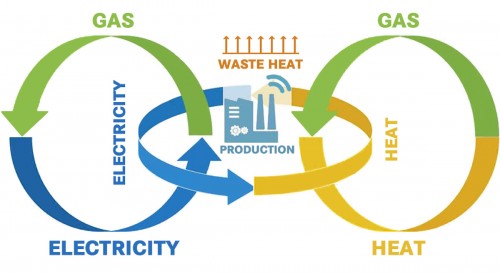
To date, grids for heat, electricity and gas are almost entirely separate; however, new technological developments make it possible to link these grids up closely bidirectionally. Hybrid grids could well play a key part in future energy supply systems in urban areas, making a major contribution to resource efficiency and energy conservation. In the OPEN HEAT GRID project, headed by the Energy Institute at Johannes Kepler University (JKU) Linz, various approaches to setting up an open heat grid were investigated and policy recommendations for open heat grids in urban energy systems drawn up. Hybrid grids need a new market and regulatory design, reflecting the upcoming interaction in previously independent grids.
Waste heat as a source of energy
Industrial firms could act as two-directional nodes between the grids for heat, electricity and gas, realizing storage and transfer potential. One main issue in this project is integrating waste heat from industry – available in large quantities, but at differing temperatures (which affects how it can be used); it can in principle be put to work in existing district heating systems. Technical barriers concern the temperature of the waste heat in relation to that of the district heating grid, and the heat extraction and its continuity. Technologies for processing and storing heat are often available, but in many cases not cost-effective.
Feeding into district heating networks
As things stand in Austria, there is no regulation on feeding heat into an existing heat grid; whoever operates a district heating grid is automatically the owner of the grid and in availability of a source of heat. This complicates negotiations about feeding in, as a number of interacting technical variables (such as flowrates, pressures, temperatures, etc.) must be taken into account. At the moment feeding in is handled by means of private contracts. For constructive negotiations and cost/benefit analyses, though, appropriate guidelines need to be developed. While the marginal cost of providing waste heat tends toward zero (since it can be made available without significant additional use energy), customizing this heat involves fixed costs, which must be redeemed by cost savings in the grid operator‘s heat production.
In Vienna and Linz such savings are feasible only in winter and in the transitional periods of spring and autumn, since in summer the energy for district heating is provided mainly by incineration. A seasonal thermal storage facility could make summer waste heat available in winter, and thus make diverting heat more cost-effective. Further investigation is planned in follow-up projects headed by the Energy Institute, such as “Future District Heating System Linz“, in partnership with AIT Austrian Institute of Technology and Linz AG.
CONTACT
Simon Moser, Energy Institute at Johannes Kepler University (JKU) Linz
moser@energieinstitut-linz.at
www.energieinstitut-linz.at